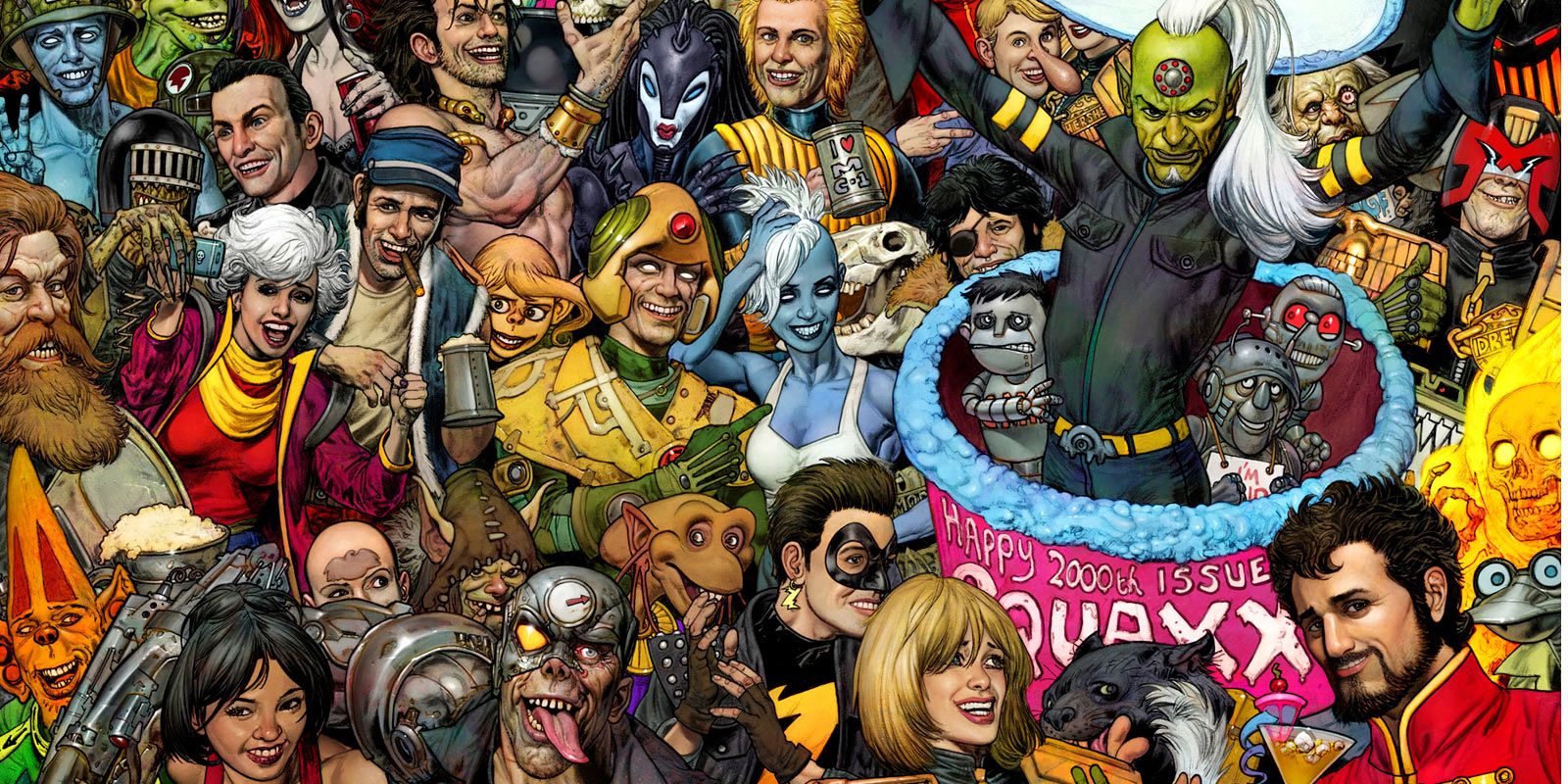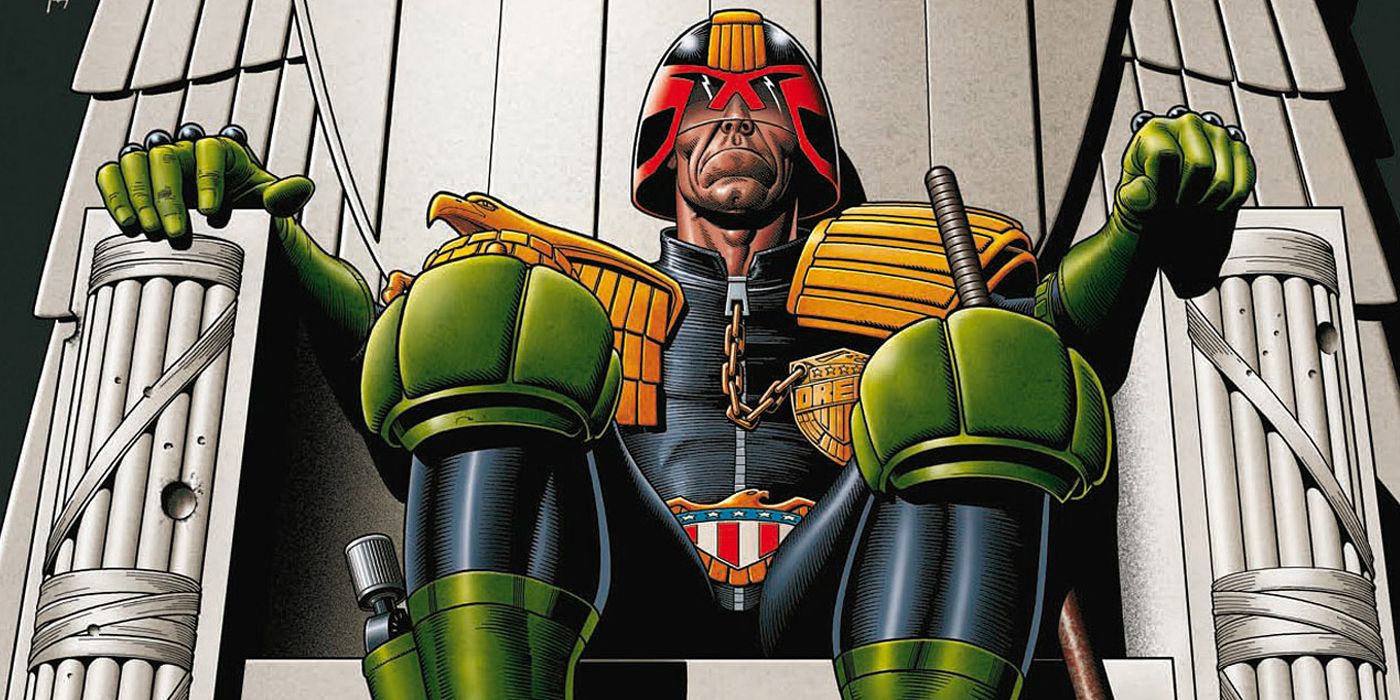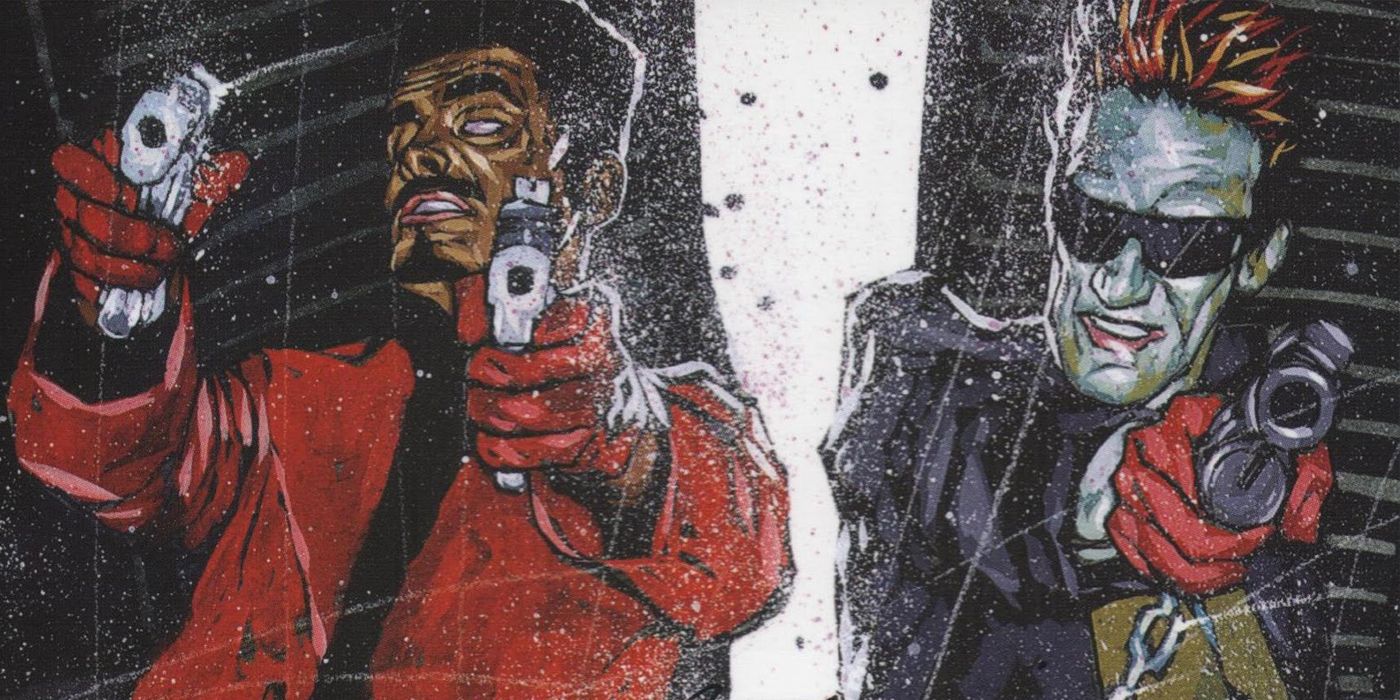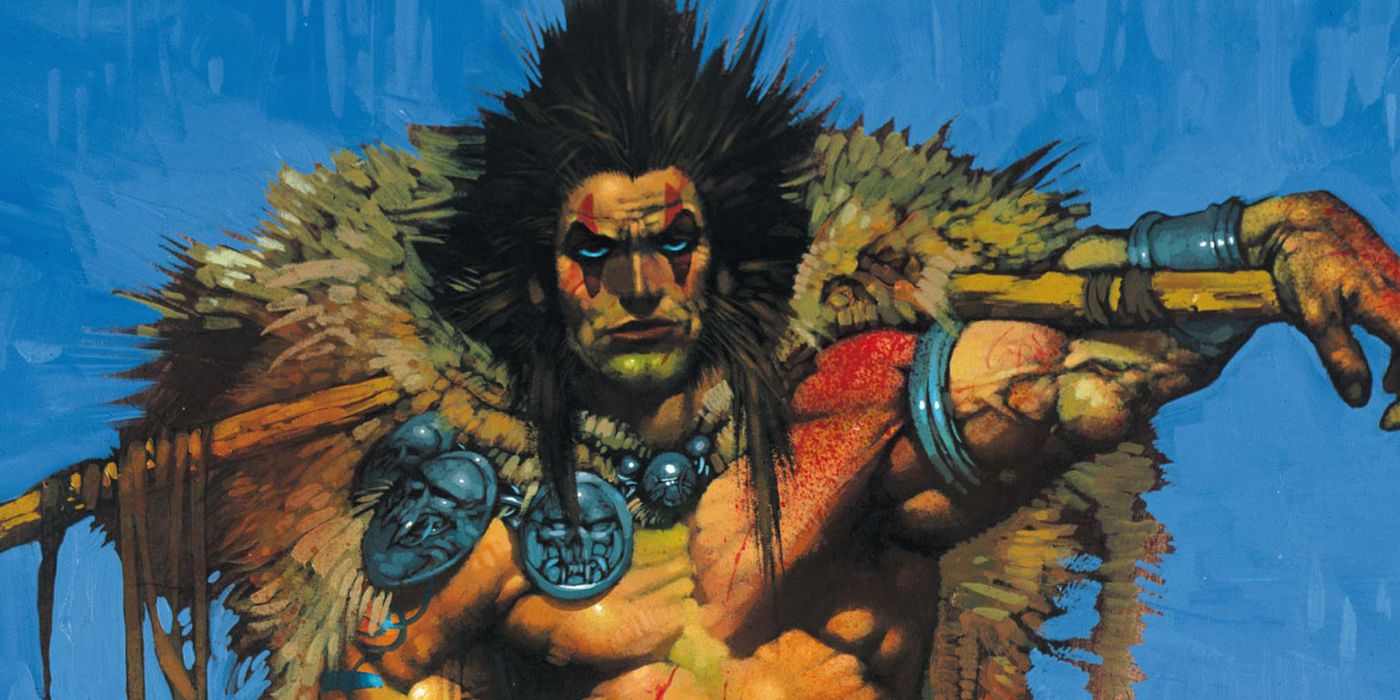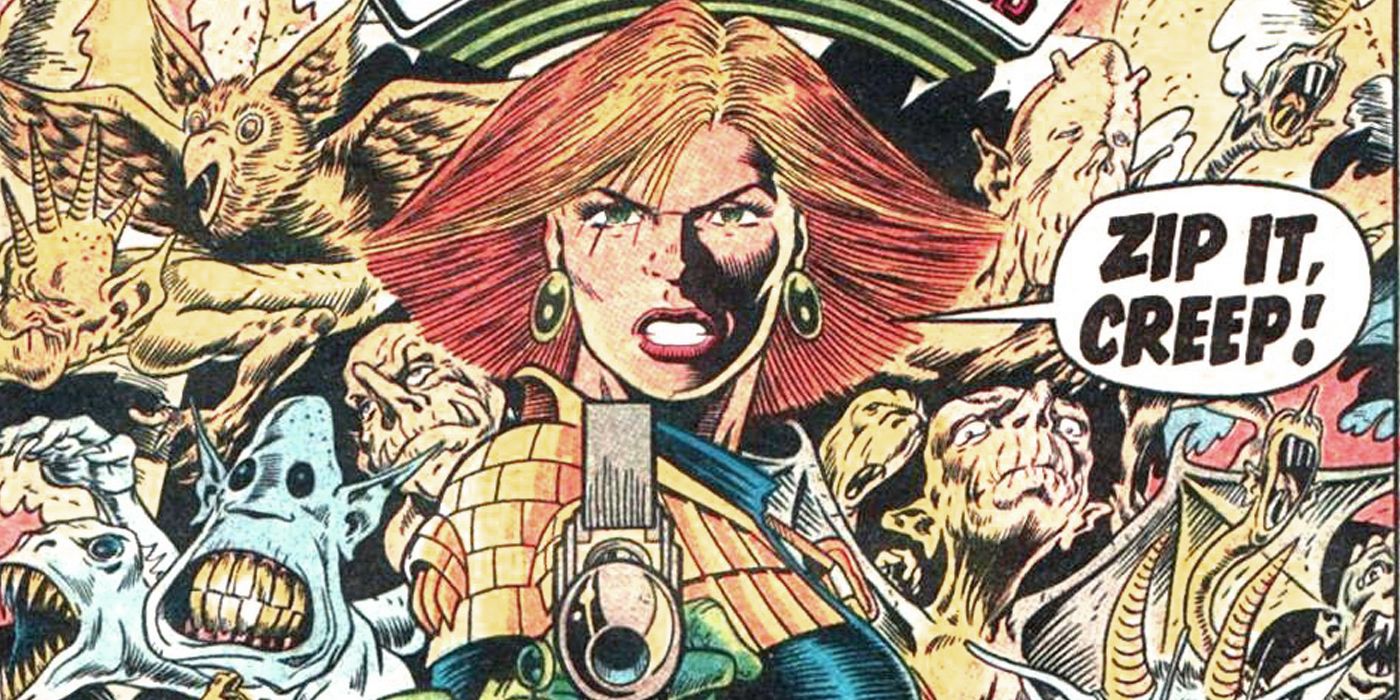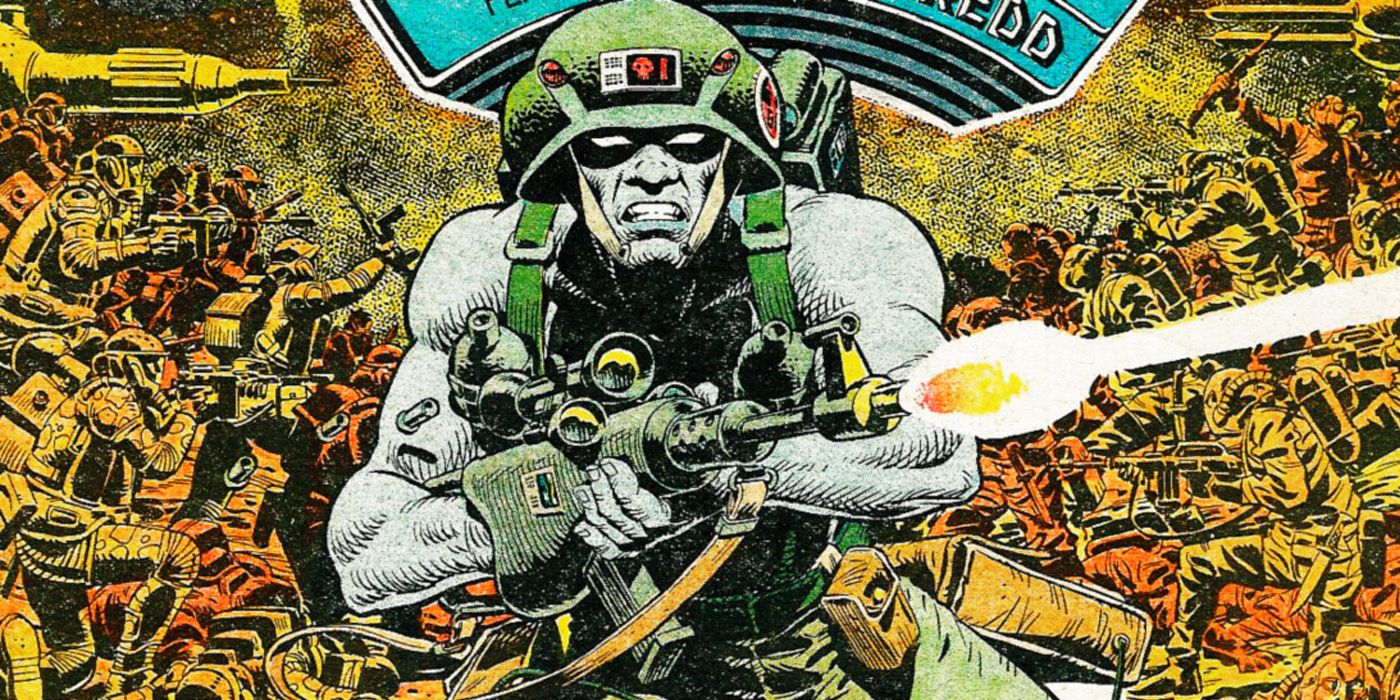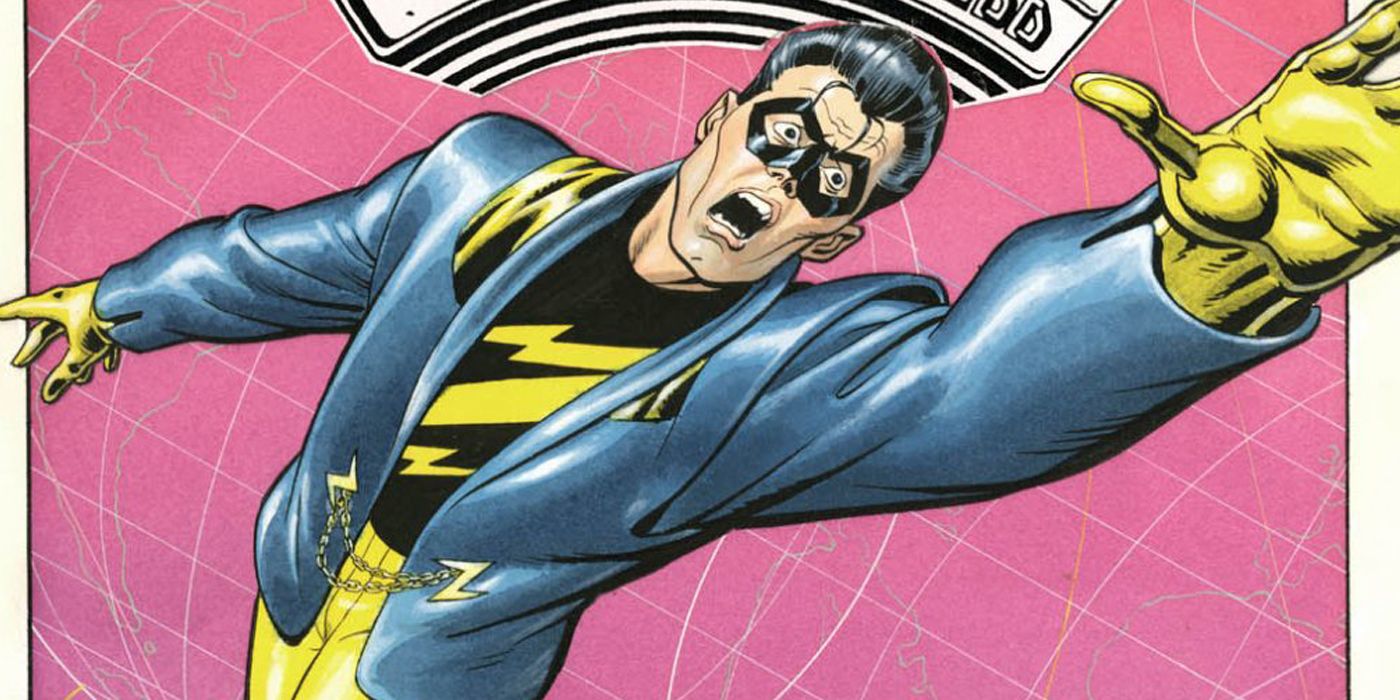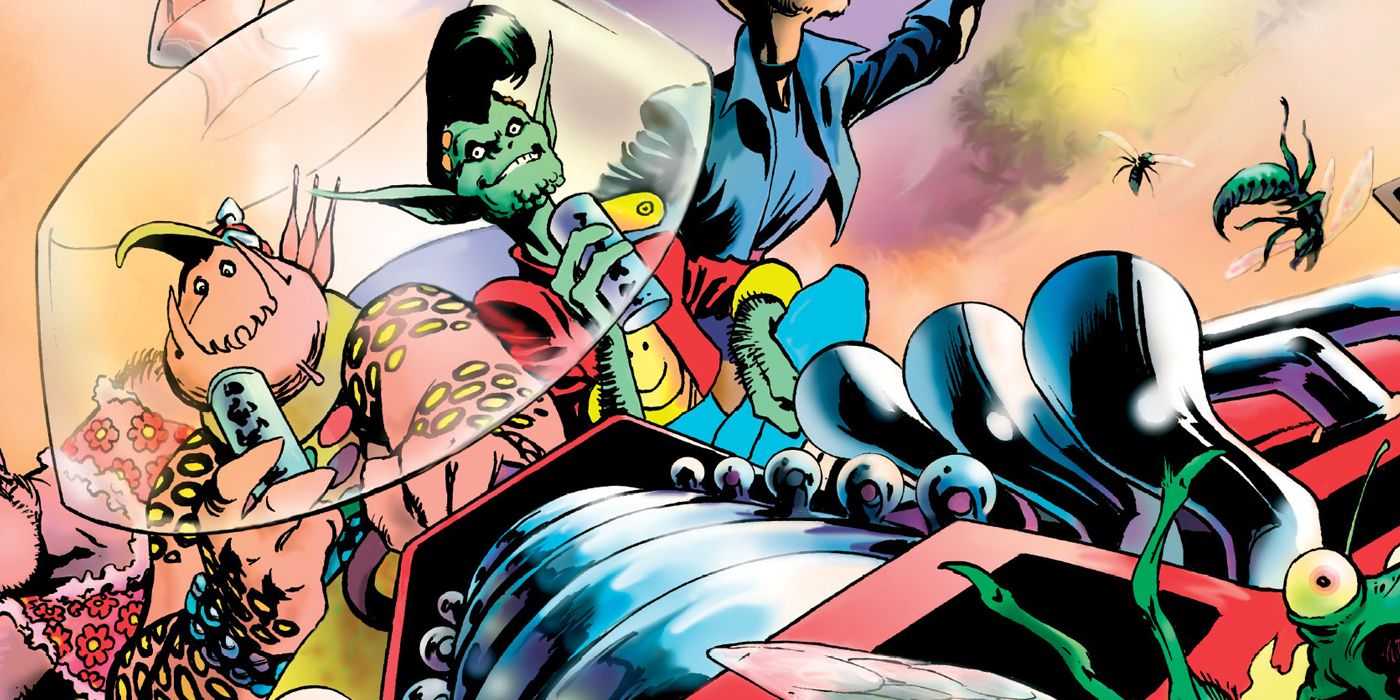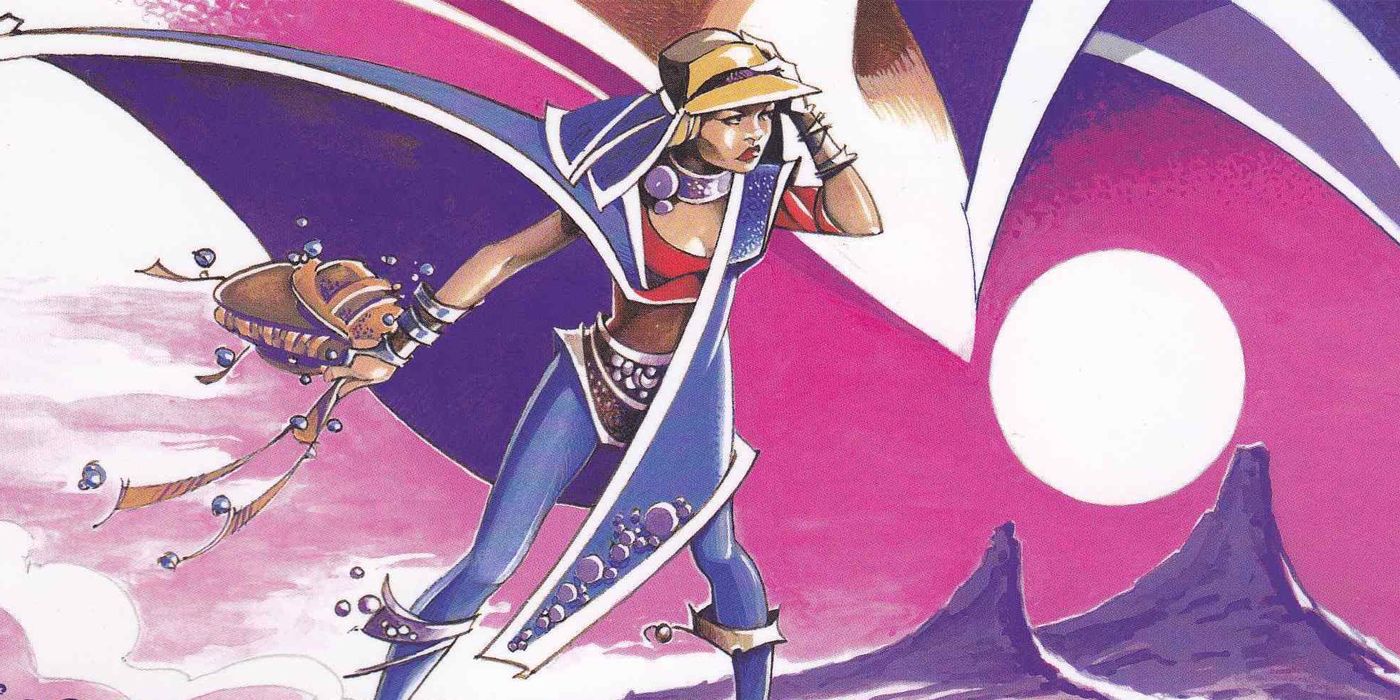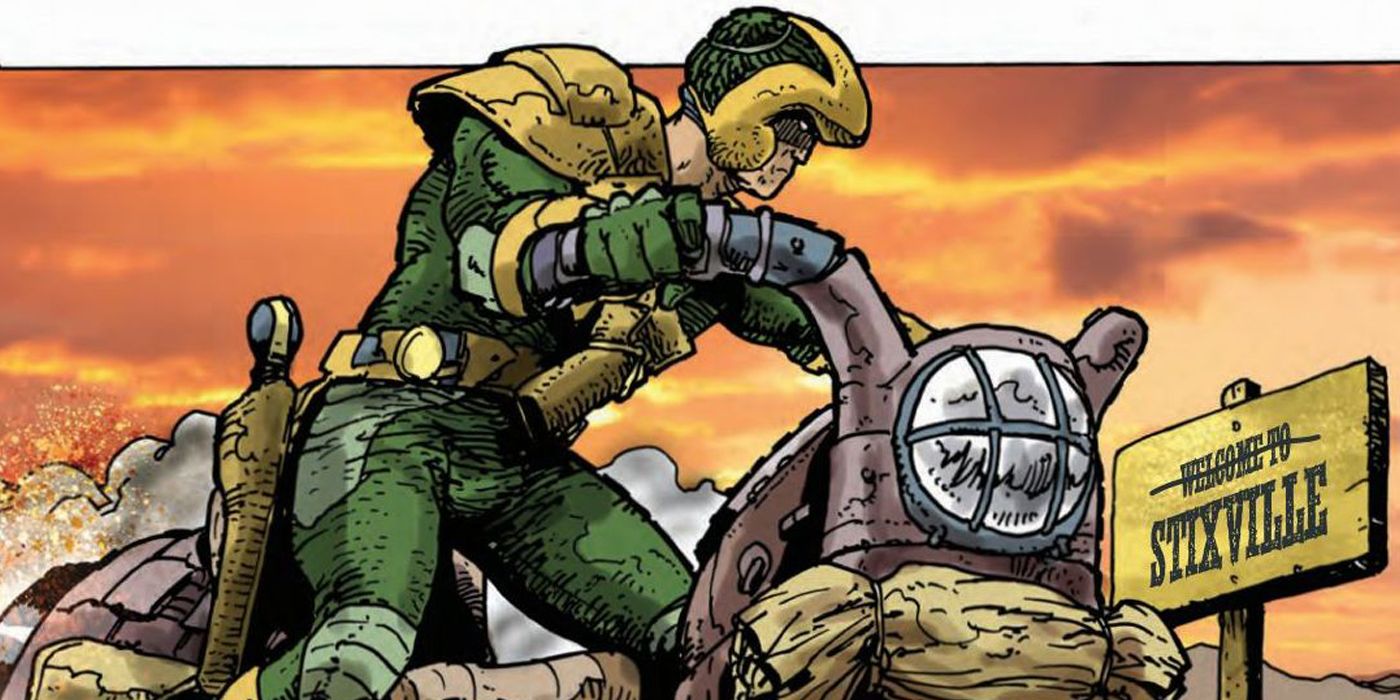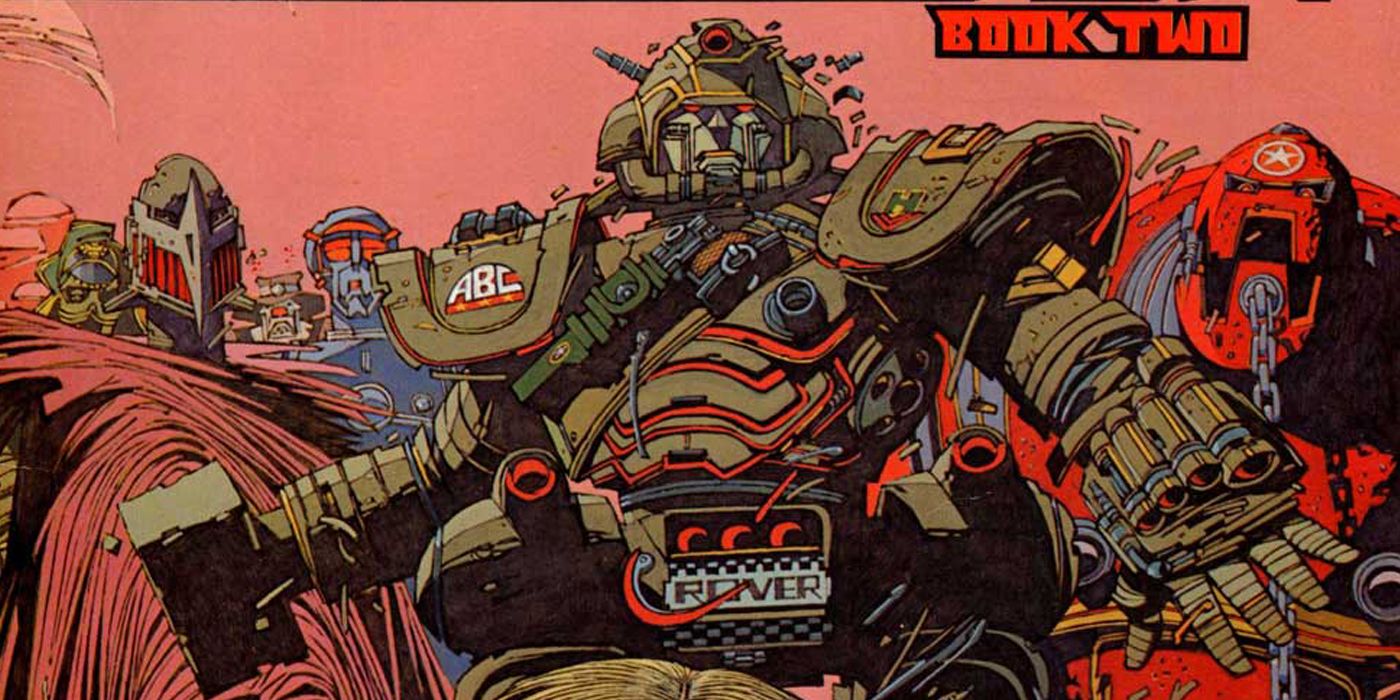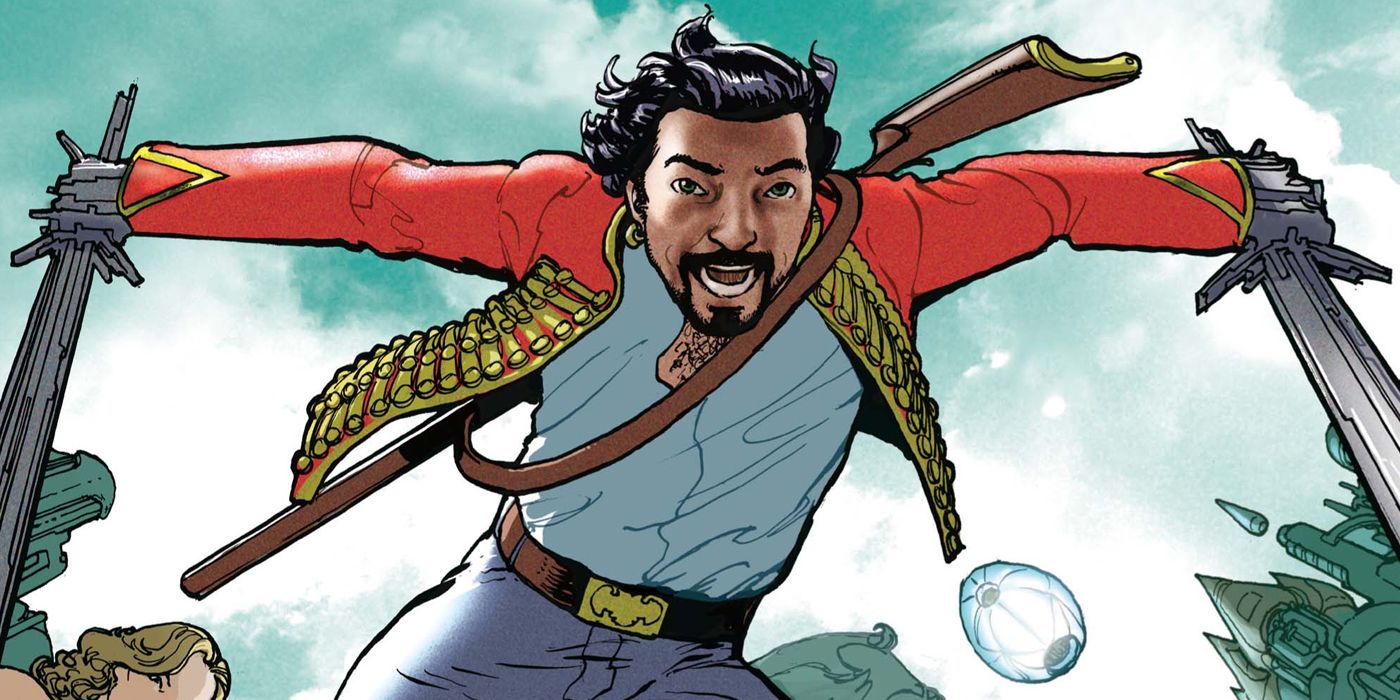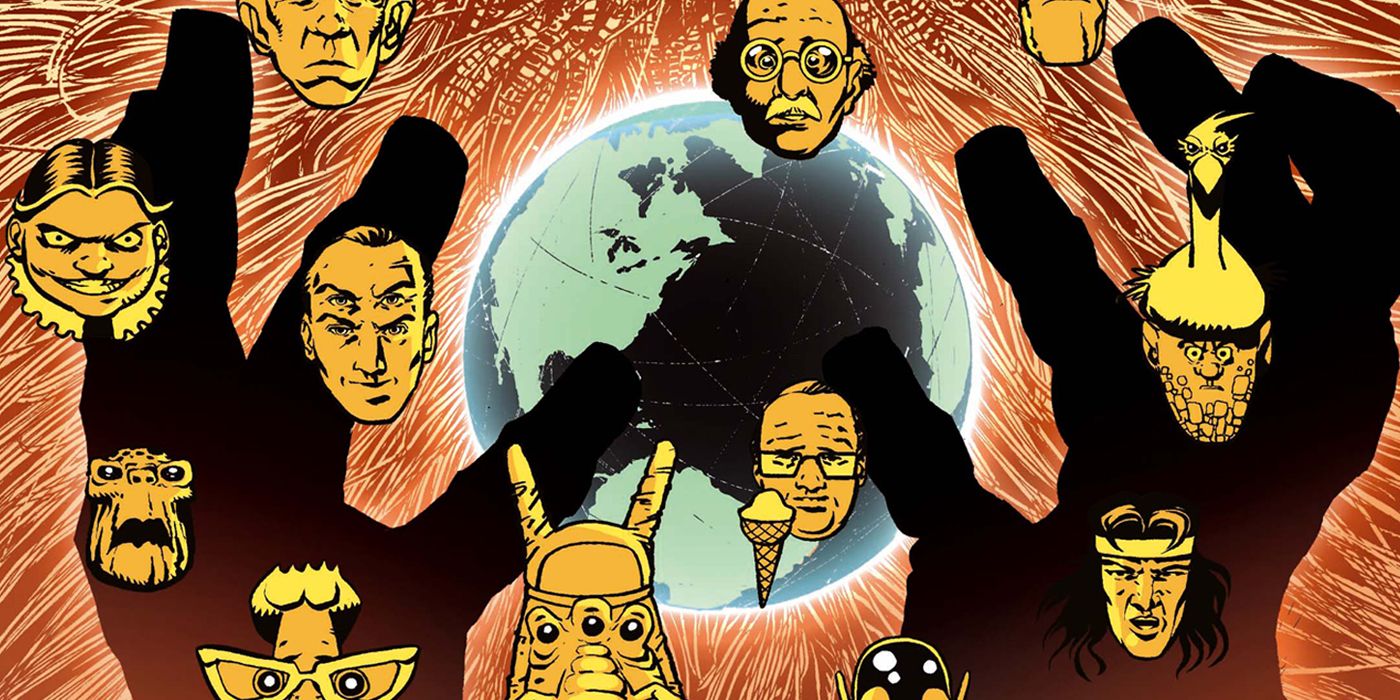From thrilling apocalyptic destruction to visceral ultra-violence, the influence of "2000 AD" can be felt in reverberations throughout all of pop culture. This week, the weekly British science fiction anthology releases its 2000th issue, or "prog" as the book's intergalactic host Tharg the Mighty might say. While "2000 AD" isn't the first comic to hit the 2000 issue mark, it is an odd book to hit such a long-running milestone.
Pat Mills and John Wagner started the book in 1977, after their contemporary action comic "Action" was banned for violence. "2000 AD" quickly defined itself with vibrant, percussive bursts of subversive energy. Through the lens of science-fiction, the book's creators were able to put the punk anti-authoritarian impulse into edgy, daring comics that enthralled and provoked its readership. The book would later provide the talent for the British Invasion that revolutionized American comics in the 1980s. "2000 AD" has survived more than its fair share of legal challenges and publishers, with the aptly-named Rebellion serving as its current home. As it approaches its 40th anniversary, the book continues to be a counter-culture staple of British comics.
RELATED: Chris Burnham Homages Classic "2000 AD" Cover for Milestone Issue
Over the years, reprints have been spotty on this side of the Atlantic, with a parade of diverse companies like Eagle, Quality, and even DC Comics reprinting "2000 AD" stories. IDW Publishing currently holds the license and has released a robust line of reprints and original stories using "2000 AD" characters. Combined with "2000 AD's" digital efforts, it's never been easier for a global audience to read some of Britain's greatest comics. In honor of this milestone issue, CBR has put together a general primer, looking in no particular order at some of the series that have made "2000 AD" the "galaxy's greatest comic."
12 Judge Dredd
While it's more than a little ironic that a humorless fascist would be the cornerstone of an anti-authoritarian punk comic, any discussion of "2000 AD" has to begin with "Judge Dredd." Created by John Wagner and Carlos Ezquerra, Dredd is a living embodiment of the law who serves as judge, jury, and executioner in Mega-City One, a dystopian future vision of the American eastern seaboard. Surrounded by the nuclear wasteland, the Cursed Earth, Mega-City One is a science-fiction fever dream generator that creators have used as the perfect backdrop for the series' pitch-black humor and ultra-violence.
In iconic stories like "Block Mania," "The Apocalypse War" and "America," Dredd has toed the line between savior and monster, becoming an incredibly complex character in the process. This complexity didn't make it into the 1995 Sylvester Stallone-starring "Judge Dredd," which plays like a kitschy "Demolition Man" rehash. The character fared far better in the darker, more action-oriented 2012 film "Dredd," starring Karl Urban. In addition to these two films, Dredd has appeared across the media landscape, appearing in everything from radio plays and novels to pinball machines and video games. In the comics world, Dredd was also given his own monthly spinoff book, "Judge Dredd: The Megazine," in 1990, and has occasionally appeared in original series from American publishers, including an ongoing series from IDW.
11 Sinister Dexter
Created by Dan Abnett and David Millgate in 1995, "Sinister Dexter" follows the impressively named Finnigan Rapunzel Sinister and Ramone Algonquin Winnibago Dexter. The pair serve as "Gun Sharks," hitmen for hire, in Downlode, a near future city that's cobbled together out of most of Central Europe. The series follows the two as they navigate the various conflicts that drive the city's underworld, taking jobs, offering protection and training new Gun Sharks. While storylines have seen these characters go from breaking out of prison to saving reality from a parallel universe mob moss, recent events have reset the pair simply as hitmen in the city.
Guided by a strict code that forbids them from harming those who haven't committed any crimes, both characters are cruel but incredibly charismatic anti-heroes. Like the works of Elmore Leonard or Quentin Tarantino, the series blends ultra violence with lighter side of a criminal underworld. Sinister, as superstitious Irish poet, and Dexter, a fashionable Spanish pop-culture aficionado, are idiosyncratic voices in what can sometimes be the aggressively depressing world of "2000 AD." These characters have become mainstays of the title, regularly appearing since their debut.
10 Sláine
While "2000 AD" is built around science-fiction, violent fantasy has also found a home in the book. Created by Pat Mills and Angela Kincaid in 1983, "Sláine" has represented the title's fantasy offerings for most of its existence. The series follows the titular Sláine, a Celtic barbarian who wanders in exile through a mystic realm called Land of the Young, accompanied by his battleaxe called "Brainbiter" and a dwarf named Ukko. Sláine fought various monsters, demons, and aliens, sometimes becoming a monster himself using his warp-spasm ability. He eventually returned to the tribe that exiled him, leading it and eventually uniting all of the other tribes in battle and becoming the King of Ireland.
Much like "Conan the Barbarian," this series follows the character's journey from lone berserker to king. With a dense Thor-esque cross-pantheon mythology, "Sláine" occupies a unique space that sets it apart from other fantasy characters. The series has often been defined by hyper-detailed, even gloriously grotesque art. Perhaps more than any other "2000 AD" series, "Slaine" benefitted from the shift to color, letting artists like Simon Bisley and Simon Davis depict "Sláine's" savage world in painted art that showcases its grotesque glory.
9 Judge Anderson: Psi-Division
With any property as successful as "Judge Dredd," spinoffs are inevitable. The most notable Dredd spinoff follows the psychic Judge Anderson in "Judge Anderson: Psi-Division." Anderson was introduced by John Wagner and Brian Bolland alongside Dredd's most iconic villains, the undead Judge Death and the Dark Judges who seek to exterminate all crime by exterminating all life. Appearing in her own stories and alongside Dredd, Anderson puts a more relatable face on Mega-City One, offering a more humanistic counterweight to Dredd's hard-line morality. Anderson and Dredd both have continued to roughly age in real time since their initial appearances, making them some of the older protagonists in comics today. Given her psychic and pre-cognitive abilities, Anderson's solo tales can take on a more distinctly supernatural tone than the main Dredd series.
Judge Anderson appeared as Dredd's partner in the 2012 film, played by Olivia Thirlby, and starred in an original solo series from IDW in 2014. "Judge Anderson: Psi-Division" has gone a long way to fill out the rest of Mega City-One, paving the way for a few more Dredd spinoffs. Some of the other Dredd spinoffs have included Mark Millar's "Red Razors," which follows a judge in the formerly Russian Sov-Bloc and more recently "The Simping Detective," which follows an undercover Mega-City One judge who dresses like a clown.
8 Rogue Trooper
Outside of the Dredd universe, Rogue Trooper might be the most famous character to come out of "2000 AD." Created by Gerry Finley-Day and Dave Gibbons in 1981, "Rogue Trooper" chronicles the exploits of Rogue, a blue-skinned "Genetic Infantryman," who fights a never-ending war on Nu-Earth, between the totalitarian Norts and the Southers. The Souther Rogue and his team are ambushed after the Traitor General reveals the location of the troops to the Norts. Then, Rogue, the lone survivor of the massacre, dedicates himself to assassinating the Traitor General, accompanied by the spirits of his team, who live on through "bio-chips" in his helmet, rifle, and backpack, respectively.
After the assassination of General Traitor, the series floundered until Gibbons returned to write a reboot of the series in 1990. The premise was roughly the same, with his "bio-chip" comrades becoming a more traditionally spiritual accompaniment. After Gibbons left, the series became more like the original version before ending in 1996. While subsequent stories have told flashback tales or focused on other characters in the "Rogue Trooper" universe, IDW attempted a short-lived original series in 2014. Rogue Trooper has also appeared in several video games, most notably a decent 2006 third-person console shooter.
7 Zenith
Until fairly recently, "2000 AD's" first superhero, "Zenith," was one of the last great major super-hero comics to remain widely unavailable. Created by Grant Morrison, Steve Yeowell and Brendan McCarthy in 1987, the series follows Robert MacDowell, an energetic super-powered brat turned pop star named Zenith. Long before "Jupiter's Legacy" covered similar ground, "Zenith" dealt with the generation gap between superheroes as Zenith worked with his super-powered parents' old teammates, the old ex-hippie heroes of "Cloud 9." As a direct response to the more grounded grim and gritty comics of the era, the series morphed into a multi-dimensional deconstruction of superhero comics.
Although it would end by 1992, "Zenith" remains a key early work by Morrison that would introduce themes and ideas about alternate dimensions and celebrity that Morrison is still working with regularly today. The celebrity hero aspects here predict other comics like "Youngblood," "X-Statix" and even his own "New X-Men." In the United States, only the first two of four "phases" of Zenith were reprinted in the 1980s, with the second half of the series not appearing at all. After a long legal dispute between Morrison and "2000 AD" regarding who owned the rights to the series, "2000 AD" collected all four "phases" of "Zenith" starting in 2014.
6 D.R. & Quinch
With the possible exception of early "League of Extraordinary Gentlemen," "D.R. & Quinch" might be the most fun comic books Alan Moore has ever written. Created in 1983 by Moore and Alan Davis, Waldo "Diminished Responsibility" Dobbs and Ernest Errol Quinch were originally intended to be one-off alien troublemakers. D.R., who looks like a cross between a Skrull and Fonzie, and Quinch, a giant "psychotic deviant," travel to Earth using a time machine and influence various events in human history through their often violent misadventures.
While Alan Davis' artwork contains its usual whimsy here, Alan Moore's involvement in this title is still surprising, considering the seriousness of so many of his works. These stories bear more resemblance to "Rick and Morty" than anything else Moore ever worked on. Sadly, the series came to an abrupt halt after five complete stories had been released. The cause was an alleged falling out between Moore and Davis regarding reprint rights to their work on "Captain Britain" for Marvel. Given its brief nature, the complete series has been collected numerous times.
5 The Ballad of Halo Jones
If Alan Moore's abrupt exist from "D.R. and Quinch" was unfortunate, the end of "The Ballad of Halo Jones" is downright tragic. Created by Moore and Ian Gibson, Halo Jones opens on the teenage lead character, a perfectly ordinary resident of an extraordinary future. Over three "books," Halo Jones leaves her life in "the Hoop" on Earth for a life among the stars, finding work on a star-cruise liner before ending up as a soldier in an interstellar war. Over time, the series evolves from looking at a detailed future into the psychological effects of war, hinting at the future that awaits Halo.
While these three books of Halo Jones make a strong story, the series was originally intended to run for another six books. However, Moore quit writing for "2000 AD" during a rights dispute regarding the character. The handful of people who have heard in full the rest of Moore's original plan for the book claim that it would have been a masterpiece, on par with Moore's and Gibbons' "Watchmen." As she had in the first three books, Halo Jones would have continued to age, and the series would have followed her throughout the rest of her life as she traveled to the edge of the universe and beyond.
4 Strontium Dog
Created by the Judge Dredd team of John Wagner and Carlos Ezquerra, "Strontium Dog" originally appeared in "2000 AD's" sister publication "Starlord." The title soon moved over to the primary "2000 AD" title, where it has remained since. "Strontium Dog" stars Johnny Alpha, a mutant in the 22nd century who can read brainwaves and see through objects with his mutant eyes. In this world, mutants began popping up after being exposed to the radioactive isotope Strontium-90 in the nuclear fallout from an atomic war. Like some other famous mutants, these deformed new mutants quickly became an oppressed minority. Johnny, the son of an anti-mutant politician, becomes a bounty hunter who, alongside his human partner Wulf, takes jobs and goes on surreal adventures throughout space and time. In the 1990 story "The Final Solution," Johnny was somewhat controversially killed off to save the mutant race.
In the wake of Johnny's death, a few spinoff series came and went, and the original creators returned to the character with a soft reboot in 1999. This reboot culminated in "The Life and Death of Johnny Alpha" which revealed the true circumstances of his initial death and brought the character back to life. Outside of comics, Johnny Alpha has appeared in a handful of novels, radio plays, and computer games.
3 ABC Warriors
Like "Strontium Dog," "ABC Warriors" has its roots in "Starlord." While "ABC Warriors" didn't officially appear in the short-lived publication, two members of the team appeared first here, including the conscientious leader Hammerstein and comic relief Ro-Jaws. Created by Pat Mills, Kevin O'Neill, Mike McMahon and Brendan McCarthy, the ABC Warriors officially debuted in 1979. They're a team of robots, designed to withstand Atomic, Bacterial and Chemical warfare, hence the acronym in the title. The robots, each with their own personality, fought in the Volgan War, a key story Mills had alluded to in numerous other series. After the war, the core team of "The Mek-nificent Seven" was sent to help settle the wild Mars frontier. After this mission was completed, the events of "Ro-Busters" took place before the Warriors were reassembled in the far future by the title character in another Mills and O'Neill series, "Nemesis The Warlock," before going their own way again.
"ABC Warriors" serves as a continuity keystone that aligns many of "2000 AD's" series into a mostly coherent timeline, linking the world of "Judge Dredd" with the far future of "Nemesis," among others. Regardless of the era, this comic about giant fighting robots managed to touch on serious themes about duty, order and "khaos" with surprising depth. One of the "ABC Warriors," Hammerstein, made a brief but memorable appearance in the 1995 "Judge Dredd" film.
2 Nikolai Dante
Created by Robbie Morrison and Simon Fraser in 1997, "Nikolai Dante" is a swashbuckling adventure series. In a future where a revitalized Russian Empire controls the Earth and much of the galaxy, Nikolai Dante discovers the illegitimate son of the Romanov Dynasty, the chief rivals of the ruling Tsar. He bonds with his family Weapon Crest, which gives him a minor healing factor and "bio-blades" that extend out of his arm. The series follows Nikolai as he fights enemies with the ruling dynasty and his own family and struggles to choose between a life guided by adventure or his aristocratic heritage.
In sharp contrast to some of "2000 AD's" other series, this romp featuring a charming scoundrel is relatively delightful. While it provides a different kind of thrill, it's an exciting recontextualization of historical aristocratic literature in a compelling sci-fi setting. A handful of spinoff novels have been produced. After an almost continuous presence in "2000 AD," the series ended, seemingly for good, in 2012.
1 Tharg's Future Shocks
While "Tharg's Future Shocks" may not be the marquee feature in "2000 AD," it captures the spirit of the anthology in a way no other series does. This is an anthology series of unconnected four-to-five page short science-fiction stories, usually defined by a sudden twist at the end. It's a remarkably simple concept, but it's been a proving ground for multiple generations of talent. Comic book icons like Alan Moore, Neil Gaiman and Grant Morrison all had some of their earliest work published in "Tharg's Future Shocks." Over the years, the feature has spawned several other variations on the basic idea throughout the "2000 AD" publishing line.
Tharg's presence in the title of this series is equally important. Tharg's Crypt Keeper-esque role in "2000 AD" might seem outdated by modern standards, but he is a unifying presence across decades of the series. While the contents of any given issue will always vary, Tharg remains, and that's important. He's both an inextricable link to the past of "2000 AD" and a herald of the future, continuing to present a fresh pool of new talent that could very well determine the future of "2000 AD."
For maximum thrill-power, stay tuned to CBR for all the latest about Judge Dredd and your favorite "2000 AD" characters.

